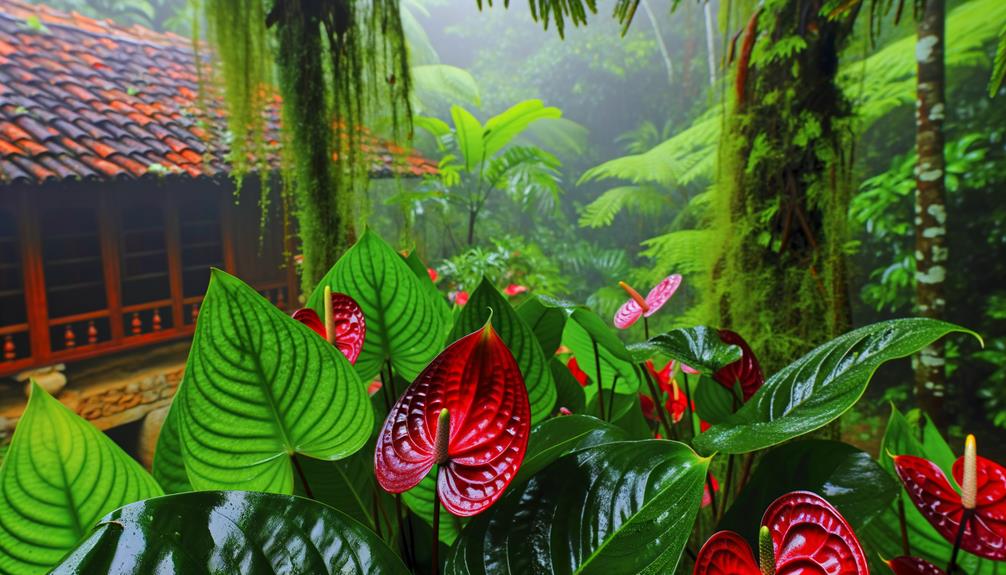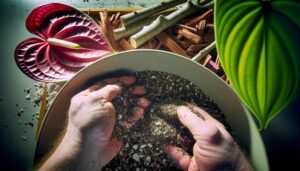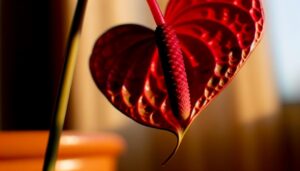Understanding the Meaning of Anthurium in Sri Lankan Culture
In Sri Lankan culture, anthuriums symbolize beauty, protection, prosperity, and love. Historically, they adorned ancient temples and aristocratic homes.
You'd find them in traditional Sri Lankan artwork and as diplomatic gifts during the Kandyan Kingdom era. Folklore depicts anthuriums as symbols of love and prosperity, often used in weddings and religious ceremonies.
They're popular in gift-giving, representing hospitality and connection to nature. Economically, the anthurium industry supports rural livelihoods and foreign exchange.
You'll notice their influence in contemporary art, embodying resilience and elegance. To fully appreciate their cultural resonance, consider their multifaceted roles in Sri Lankan society.

Key Takeaways
- Anthurium symbolizes beauty, elegance, and prosperity in Sri Lankan culture.
- Historically used in temple decorations, aristocratic homes, and diplomatic gifts during the Kandyan Kingdom.
- Represents love, protection, and good fortune in folklore and ceremonies.
- Popular gift for weddings, housewarmings, and birthdays, symbolizing hospitality and prosperity.
- Significant economic contributor, supporting employment and skill development in rural areas.
Historical Significance
Anthurium has played a pivotal role in Sri Lankan culture, symbolizing beauty and elegance in various historical contexts. You can trace its influence back to ancient temple decorations, where it was often used to adorn altars and ceremonial spaces. The anthurium's vibrant colors and unique shape made it an ideal choice for such sacred environments.
In aristocratic households, these flowers were a status symbol, representing wealth and refined taste. Historical records show that during the Kandyan Kingdom, anthuriums were exchanged as diplomatic gifts, underscoring their significance.
When you explore traditional Sri Lankan artwork, you'll notice the frequent depiction of anthuriums, highlighting their cultural importance. This deep-rooted historical significance reflects the enduring appreciation for this elegant flower in Sri Lankan society.
Symbolism in Folklore
In Sri Lankan folklore, the anthurium frequently symbolizes prosperity and protection, often appearing in tales that emphasize its mystical qualities.
You'll find stories where villagers plant anthuriums to ward off evil spirits and attract good fortune. The flower's vibrant red hue is believed to channel positive energy, creating a protective shield around homes.
In ancient narratives, the anthurium often appears as a gift from deities, signifying divine favor and blessings. It's not just a plant; it's a powerful emblem interwoven with cultural beliefs and superstitions.
Role in Ceremonies
During traditional Sri Lankan ceremonies, you'll often see the vibrant anthurium playing a central role, symbolizing both aesthetic beauty and cultural significance. At weddings, these striking flowers adorn altars and banquet tables, representing love and prosperity. Their lush, heart-shaped bracts add an elegant touch to the decor, enhancing the visual appeal.
In religious ceremonies, anthuriums are frequently offered at temples as a sign of devotion. They also appear in harvest festivals, where their bright colors symbolize a bountiful season.
The cultural context elevates the anthurium beyond mere decoration; it's a revered element that connects the community to its heritage. By incorporating these flowers, you honor traditions and bring a sense of continuity and reverence to the occasion.
Gift-Giving Traditions
You'll find that anthuriums hold profound symbolic significance in Sri Lankan gift-giving traditions, often representing hospitality and good fortune.
When exploring popular gifting occasions such as weddings, birthdays, and housewarmings, it's clear that these vibrant flowers are more than mere decorative items.
Understanding their cultural context underscores why anthuriums remain a cherished choice for meaningful presents.
Symbolic Significance Explained
Anthuriums, with their vibrant colors and unique shapes, hold profound symbolic importance in Sri Lankan gift-giving traditions, representing hospitality, love, and prosperity. When you give an anthurium, you're not just offering a beautiful flower but also conveying deep meanings.
The plant's heart-shaped spathe symbolizes love and affection, making it an ideal gift for loved ones. Its bright hues, often red or pink, signify warmth and welcome, reflecting the strong cultural value placed on hospitality.
Additionally, the anthurium's resilient nature and long-lasting blooms are seen as a symbol of enduring prosperity and good fortune. By understanding these symbolic layers, you'll appreciate why anthuriums are cherished gifts in Sri Lanka's cultural tapestry, enriching relationships and expressing heartfelt sentiments.
Popular Gifting Occasions
In Sri Lankan culture, various special occasions like weddings, housewarmings, and religious ceremonies are enriched by the tradition of gifting anthuriums, each occasion amplifying the flower's symbolic meanings.
At weddings, anthuriums represent hospitality and long-lasting relationships, making them ideal for newlyweds.
During housewarming parties, they signify prosperity and a welcoming atmosphere, embodying the wish for a harmonious home.
In religious ceremonies, especially Buddhist events, anthuriums are offered for their purity and elegance, reflecting spiritual devotion.
By choosing anthuriums as gifts, you're not just giving a beautiful flower but also conveying deep cultural values and well-wishes.
This tradition underscores the intricate ways in which Sri Lankans use flora to express sentiments and foster connections.
Decorative Uses
Adorning homes and public spaces with anthuriums has become a hallmark of Sri Lankan decorative practices, reflecting both aesthetic preferences and cultural significance. You'll find these vibrant flowers enhancing everything from living rooms to hotel lobbies. Their striking colors and unique shapes make them ideal for various decor styles, seamlessly blending traditional and contemporary elements.
| Context | Decorative Usage |
|---|---|
| Homes | Centerpieces, living room accents |
| Offices | Reception areas, meeting rooms |
| Hotels | Lobbies, guest rooms, event halls |
| Religious Sites | Altars, ceremonial decorations |
| Public Spaces | Parks, community centers, exhibitions |
Their presence is not merely ornamental; it symbolizes warmth, hospitality, and a connection to nature. By incorporating anthuriums into your decor, you're embracing a rich cultural tradition while adding a touch of elegance.
Medicinal Uses
While mainly celebrated for their decorative appeal, anthuriums have also found their way into traditional Sri Lankan medicinal practices.
You'll find that these vibrant flowers aren't just for show; they're believed to possess properties that aid in treating various ailments. Locals often use anthurium extracts to address skin conditions and inflammations.
The leaves and roots are sometimes utilized in poultices to reduce swelling and pain. Additionally, anthuriums are thought to have purifying properties, making them a component in herbal remedies aimed at detoxification.
Although not extensively documented in modern scientific literature, these traditional uses highlight the plant's multifunctional role. Understanding these applications helps you appreciate the deeper cultural significance of anthuriums in Sri Lanka.
Economic Importance
You can't overlook the economic importance of anthurium in Sri Lanka. It greatly boosts export revenue, making it a key player in the country's floriculture sector.
Additionally, the cultivation and exportation of anthuriums create numerous employment opportunities, supporting local communities and contributing to economic stability.
Export Revenue Contribution
Anthurium exports significantly boost Sri Lanka's economy by generating substantial foreign exchange revenue. When you consider the worldwide demand for these vibrant flowers, it's evident why Sri Lanka has seized the opportunity to become a leading exporter.
The country's favorable climate and skilled horticultural practices contribute to producing high-quality anthuriums that appeal to international markets. By exporting to countries like Japan, the Netherlands, and the United States, Sri Lanka secures a steady influx of foreign currency.
This revenue strengthens the national economy, allowing for further investment in agricultural technology and infrastructure. Consequently, the export of anthuriums not only enhances trade relations but also underscores Sri Lanka's strategic role in the global floriculture industry.
Employment Opportunities Creation
Beyond generating significant foreign exchange revenue, the anthurium industry in Sri Lanka also plays a pivotal role in creating employment opportunities across various sectors.
You'll find that from cultivation to distribution, this industry engages a wide range of labor. Farmers, horticulturists, and skilled laborers are needed for planting, nurturing, and harvesting these flowers. Additionally, roles in packaging, marketing, and logistics further expand job prospects.
This sector doesn't just provide employment; it fosters skill development and enhances livelihoods. By supporting rural economies and reducing urban migration, the anthurium industry promotes socio-economic stability.
Hence, your understanding of its economic importance isn't complete without acknowledging its substantial contribution to employment and community well-being in Sri Lanka.
Growing Conditions
In order to thrive, anthuriums require specific growing conditions that align closely with the humid, tropical climate of Sri Lanka. You'll want to make sure a temperature range between 70-90°F.
High humidity is essential, ideally above 80%, to mimic their natural rainforest habitat. Indirect light works best, as direct sunlight can scorch the leaves.
Well-draining soil enriched with organic matter is necessary to prevent root rot, a common issue in waterlogged conditions. Regular watering is important, but let the top layer of soil dry out between watering sessions.
Fertilize monthly with a balanced, slow-release fertilizer to support their vibrant blooms. By replicating these conditions, you'll cultivate healthy, flourishing anthuriums that reflect their cultural significance in Sri Lanka.
Modern Interpretations
In modern Sri Lankan culture, anthuriums have taken on new meanings and uses. They appear frequently in contemporary art as symbols of elegance and resilience. They are favored in gifting trends for their vibrant and lasting beauty. Anthuriums also inspire innovative floral designs that push creative boundaries.
This evolution highlights how traditional elements adapt to contemporary contexts, enriching cultural narratives.
Symbolism in Contemporary Art
Today, you'll find that contemporary Sri Lankan artists often use the anthurium to explore themes of identity, resilience, and cultural heritage. By incorporating this vibrant flower, they tap into its rich symbolism tied to both personal and collective narratives.
The anthurium's striking red hue often represents passion and strength, reflecting the resilience of the Sri Lankan spirit. Artists might juxtapose the flower with traditional motifs, creating a dialogue between past and present. You'll see it in mixed media, paintings, and installations, where its form and color provoke thought about cultural continuity.
This modern interpretation not only celebrates aesthetic beauty but also invites viewers to reflect on deeper societal issues and shared histories.
Popular Gifting Trends
You'll notice that the anthurium has become a versatile and meaningful choice in modern gifting trends, reflecting both aesthetic appeal and cultural significance. People now gift anthuriums for various occasions, symbolizing love, hospitality, and prosperity. Their vibrant colors and unique shapes make them suitable for birthdays, weddings, and corporate events. Here's a breakdown to illustrate:
| Occasion | Meaning | Popular Color |
|---|---|---|
| Birthdays | Celebration | Red |
| Weddings | Love and Unity | White |
| Anniversaries | Everlasting Love | Pink |
| Corporate Gifts | Prosperity and Growth | Green |
| Housewarmings | Warmth and Welcome | Orange |
Analyzing these trends, you'll see how anthuriums seamlessly blend tradition with contemporary practices, making them a cherished gift in Sri Lanka.
Floral Design Innovations
Floral design innovations in Sri Lanka have embraced anthuriums, transforming traditional arrangements into contemporary masterpieces that captivate and inspire.
You'll notice that modern interpretations often incorporate bold color contrasts and sleek, minimalist vases, elevating the anthurium's vibrant hues and unique shapes. By integrating elements like geometric containers and metallic accents, designers create a striking visual impact that redefines elegance.
Moreover, the use of mixed media, such as glass and ceramics, introduces a tactile dimension that enhances the sensory experience.
These innovations don't just focus on aesthetics but also on sustainability, using locally sourced materials and eco-friendly practices. Understanding these modern interpretations helps you appreciate the creative evolution of anthurium arrangements in Sri Lankan culture, blending tradition with contemporary artistry.
Artistic Representations
Anthuriums have been intricately woven into Sri Lankan art, symbolizing not only the island's rich natural beauty but also its deep cultural heritage. You can see these flowers in various artistic expressions, reflecting their cultural significance.
Here are four key areas:
- Traditional Paintings: Artists often depict anthuriums in vibrant, detailed canvases that highlight their unique shape and color.
- Sculptures: These flowers are carved into wood and stone, representing life and importance.
- Textiles: Intricate patterns of anthuriums are woven into fabrics and garments, showcasing their beauty in everyday life.
- Ceramics: Pottery and ceramic crafts frequently feature anthurium motifs, blending function with artistic flair.
Each form captures the essence of anthuriums, making them essential to Sri Lankan artistic heritage.
Global Influence
While anthuriums hold a cherished place in Sri Lankan art, their influence extends far beyond the island, permeating global horticultural and design communities.
You'll find these vibrant flowers adorning homes and gardens worldwide, symbolizing hospitality and exotic beauty. In horticulture, they're admired for their striking appearance and relatively easy care, leading to widespread cultivation.
Designers incorporate anthuriums into modern interior aesthetics, leveraging their bold colors and unique shapes to create visually stunning spaces. Florists often use them in high-end arrangements, capitalizing on their longevity and allure.
This cross-cultural appreciation highlights the flower's versatility and universal appeal, demonstrating how a symbol rooted in Sri Lankan tradition can captivate a global audience.
Conclusion
In exploring anthuriums within Sri Lankan culture, you've navigated through a tapestry rich in history, symbolism, and modern relevance. Like a vibrant thread weaving through ceremonies, folklore, and everyday life, these flowers symbolize more than beauty—they embody cultural heritage.
Whether gifted or grown, anthuriums continue to flourish, bridging past and present.
So, the next time you see an anthurium, remember it's not just a flower; it's a living declaration to Sri Lanka's enduring traditions.






